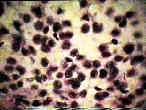- See: Bone Tumor Menu
- Discussion:
- age at presentation:
- most common primary epiphyseal tumor in children is chondroblastoma;
- most commonly arises between ages 10 to 30;
- not infrequently, the tumor will also arise in adults;
- the adults counterpart of chondroblastoma is giant cell tumor;
- in the report by Ramappa AJ, et al, 62 % of the 47 patients were 20 of age or younger (in contrast, 38% of patients will be
well beyond skeletal maturity);
- location:
- lesions are distributed widely in the skeleton, but most were in the epiphyses or apophyses;
- most lesions occur in the proximal part of the tibia (17%) and the proximal part of the humerus (15%); (Ramappa AJ, et al)
- may occur in the apophysis of the greater trochanter;
- of note, chondroblastoma is the most common tumor affecting the patella, followed by giant cell tumor;
- metastatic lesions are uncommon but due occur;
- males more affected than females;
- diff dx:
- only three tumors may invade physis: chondroblastoma, GCT, and clear cell chondrosarcoma;
- GCT of bone:
- GCT usually arises in the 3-4 decade (where as chondroblastoma arises in the second);
- GCT may expand to both the epiphysis and diaphysis;
- clear cell chondrosarcoma (see chondrosarcoma)
- clear cell sarcoma is rare, slow growing, locally recurrent tumor easily confused with chondroblastoma but malignant;
- epiphyseal osteomyelitis: (see: osteomyelitis);
- ref: Primary subacute epiphyseal osteomyelitis.
- Clinical Presentation:
- painful - motion limiting, benign tumor arising during adolescence;
- majority are active stage 2 lesions;
- Radiographs:
- look for epiphseal radiolucent lesion w/ fine punctate calcifications (mineralization and a well-marginated rim of reactive bone);
- oval osteolysis located eccentrically in the epiphysis;
- slight bone expansion and broading of cortex;
- tumor is usually bordered by a well defined margin of reactive bone.
- note the amount of epiphyseal involvement and whether the tumor crosses the growth plate;
- stage 3 chondroblastoma may extends thru growth plate into metaphysis or through articular cartilage into the joint;
- in some cases, the tumor will erode through the subchondral bone;

- CT Scan:
- useful in demonstrating tissue density, extent of epiphyseal involvement, and often most imporatant location
of lesion in relation to the articular and epipyseal cartilage;
- Histology of Chondroblastoma:
- may contain areas that are histologically identical to aneurysmal bone cyst
- Treatment:
- because condroblastoma may extend upto subcondral bone, it is difficult to perform marginal excision or complete curettage;
- in older adolescents, currettage of growth plate may promote ephyseal closure (which avoids angular deformities);
- references:
- What Happens to the Articular Surface After Curettage for Epiphyseal Chondroblastoma?
- stage 2
- most chondroblastomas are active stage 2 tumors which are amenable to treatment by curettage w/ moderate risk of recurrance;
- consists of intralesional curettage and packing with allograft or autograft bone chips or polymethylmethacrylate
- it is important to avoid joint penetration because chondroblastoma cells will grow in joint fluid;
- addition of methylmethacrylate to defect may be added to curettage to prevent recurrence;
- stage 3 chondroblastoma (most common in pelvis) is not amenable to curettage due to 50% recurrance rate;
- wide excision is the treatment of choice, if technically possible;
- stage 3 will require en bloc excision;
- these may metastasize to the lungs;
- 7 patients (15 %) had a local recurrence; 3 of them had a second recurrence and one, a third recurrence;
- patients w/ lesions around the hip (proximal femur, greater trochanter, and pelvis) are significantly more likely to develop
recurrences as well as metastatic lesions (Ramappa AJ, et al)
Chondroblastoma. A review of seventy cases.
Chondroblastoma of bone: long-term results and functional outcome after intralesional curettage.
Treatment and Prognosis of Chondroblastoma.
Chondroblastoma of bone in the extremities: a multicenter retrospective study.
Clinical and radiological long-term results after operative treatment of chondroblastoma

